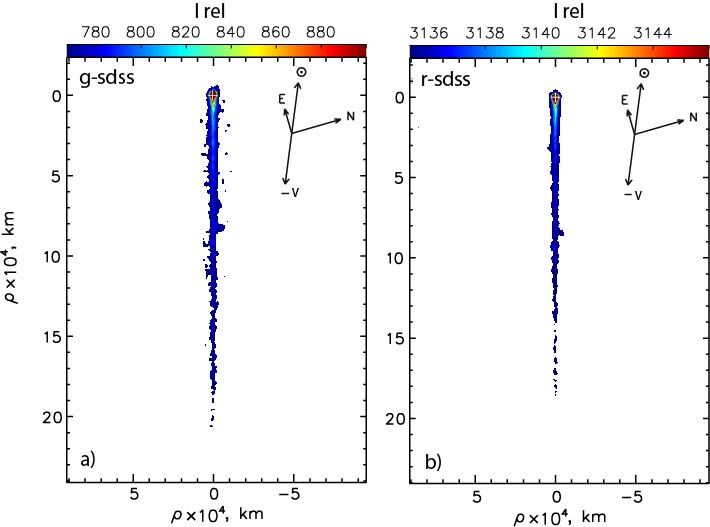Dust environment of active asteroid (248370) 2005 QN173
- 1Astronomical Institute Slovak Academy of Sciences, Slovakia (oivanova@ta3.sk)
- 2Astronomical observatory, Taras Shevchenko National University of Kyiv, Ukraine
- 3Main Astronomical Observatory of the National Academy of Sciences of Ukraine, Ukraine
Abstract
The results of imaging photometric, polarimetric, and long-slit spectroscopic observations of active asteroids (248370) 2005 QN173 are presented. Average values of the polarization respect to the typical value of polarization observed for C-type asteroids. Using our observations of the asteroid, we attempted to model the physical characteristics of the dust particles in the coma and tail.
Introduction
Comets, asteroids, and meteoroids compose the population of small bodies in the Solar System. Comets and asteroids are traditionally considered as remnants of the matter that were left from the initial and subsequent stages in the epoch of Solar System formation, and investigations of these objects are necessary for understanding the circumstances of the early history of the Solar System. A classical notion of asteroids presumes that they are non-active objects mainly composed of non-volatile material. Now a group of small bodies named “active asteroids” was observed. This group goes beyond the classical definition and includes objects of the transitional class, which are observed in the Main belt (MB) of asteroids [1]. A specific feature of these objects is that their dynamic characteristics are typical of asteroids (their orbits belong to the asteroid-type), while they exhibit signs of cometary activity, i.e., the cometary coma with dust or gas tails [1-3]. These signs may appear periodically or on a non-recurring basis. Several ways of mass loss were considered for eleven objects of this type by Jewitt [1], who called these objects active asteroids, although some of them are not members of MB asteroid [4-6]. Usually, the following activity-inducing mechanisms are proposed: meteoroids bombardment of the surface of asteroids, instability of their rotation, thermal effects, matter release due to electrostatic forces, and the sublimation of volatile compounds [1,2,7]. Moreover, for some primitive MB asteroids, which have orbits typical of asteroids, sublimation activity during their perihelion passages was confirmed [8]. To date, cometary activity has been observed in almost 20 small bodies of the Solar System, which are known as active asteroids [1, 9].

Figure 1: Intensity images of the asteroid in g- and r-sdss filters.
In this work, we study one of the distant asteroids (248370) 2005 QN173, with perihelion distance q= 2.373 au.
Observations
The observations of (248370) 2005 QN173 were made with the 6-m telescope BTA SAO and the 2.5-m telescope of the CMO SAI MSU from July to November 2021, when heliocentric and geocentric distances of the comet were 3.08-3.26 and 3.82-2.95 au, and phase angle was 8-23 degrees. Imaging polarimetric, photometric, and long-slit spectroscopic observations of the asteroid were performed. The observations were taken with a multimode focal reducer SCORPIO-2 of the SAO. A 1024×1024 CCD with a full field of view of 6.1'×6.1' and a pixel scale of 0.18 arcsec/px was used as a detector. Photometrical observations were acquired using the broadband filters.
Results
The analysis of spectra and the spatial distribution of intensity, color, and linear polarization over the coma revealed the following features.
Spectroscopy
No emission lines were detected. We determined upper limits to the emission fluxes of the main neutrals of comets and ion CO+ and upper limits to the production rates of the molecules CN, C3, C2 using Haser model [10].
Photometry and polarization
The active asteroid showed long-lasting activity with a compact coma and long dust tail from July to November 2021 (Fig.1). The dust production was estimated as Afρ~20 cm in the r-sdss filter. Polarization maps of this asteroid show spatial variations of polarization over the coma from about 0.5% up to 1.5% at phase angles α=23° and about -0.7% to -1.3%, which may be related to changes in physical properties of the dust particles. Average values of the polarization correspond to the typical value of polarization observed for C-type asteroids. Our photometrical observations of the asteroid allowed us to use g–r color map to analyze dust properties in the dust coma and tail. From the color map, the dust color is ~0.43m near the optocenter. The color increases with distance from the optocenter.
Acknowledgements
OI, MH are supported, in part, by the Slovak Academy of Sciences (grant Vega 2/0059/22) and the Slovak Research and Development Agency under the Contract no. APVV-19-0072. Authors are grateful Shablovinskaya E. (SAO), Voziakova O. and Safonov B. (SAI MSU) for obtained observation of the asteroid at 6-m and 2.5-m telescopes, respectively.
References
[1] Jewitt, D.: The active asteroids, Astron. J., 2012, vol. 143, pp. 66–80.
[2] Neslushan, L. et al: Dust productivity and impact collision of the asteroid 596 (Scheila), Planet. Space Sci., 2016, vol. 125, pp. 37–42.
[3] Kokhirova, G.I. et al.: Results of complex observations of asteroid (596) Scheila at the Sanglokh International Astronomical Observatory, Sol. Syst. Res., 2018, vol. 52, pp. 495– 504.
[4] Jewitt, D. et al.: Main belt of asteroids comet P/2008 (Garradd), Astron. J., 2009, vol. 137, pp. 4313–4321
[5] Hsieh, H. et al.: Physical properties of Main-Belt Comet P/2005 U1 (Read), Astron. J., 2009a, vol. 137, pp. 157–168.
[6] Hsieh, H. et al.: Albedos of mainbelt comets 133P/Elst-Pizarro and 176P/LINEAR), Astrophys. J. Lett.: 2009b, vol. 694, pp. L111–L114.
[7] Hsieh, H.: Active asteroids: Main-belt comets and disrupted asteroids, Proc. IAU, 2016, vol. 29A, pp. 237–240.
[8] Busarev, V.V., Detection of the influence of solar activity on the sublimation activity of primitive asteroids, Phys. Curr. State Pros. 2018, vol. 2, pp. 47–50.
[9] Jewitt, D. et al.: The active of asteroids, in Asteroids IV, Michel, P., DeMeo, F., and Bottke, W., Eds., Tucson: Univ. Arizona Press, 2015, pp. 221–241.
[10] Haser, L.: Distribution d’intensite dans la tete d’une cometes, Bull. Soc. R. Sci. Liege, Vol. 43, pp. 740–750, 1957.
How to cite: Ivanova, O., Luk’yanyk, I., and Husárik, M.: Dust environment of active asteroid (248370) 2005 QN173, Europlanet Science Congress 2022, Granada, Spain, 18–23 Sep 2022, EPSC2022-203, https://doi.org/10.5194/epsc2022-203, 2022.

